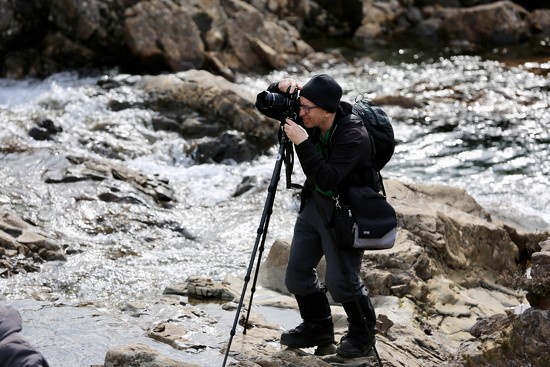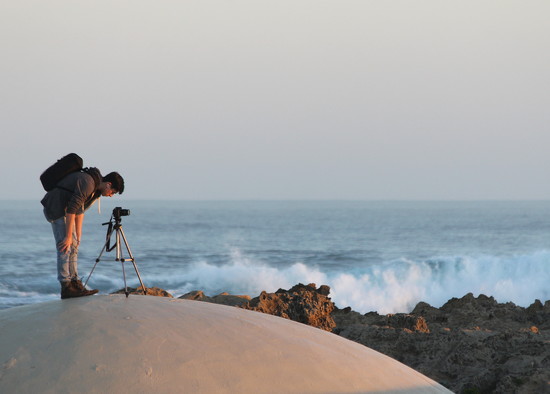There is something magical about a daytime long exposure, transforming usually familiar surroundings into unusual dramatic landscapes using nothing more than a Neutral Density (ND) filter.
ND filters cut out the amount of light coming into the lens allowing the shutter to be left open for much longer, capturing movement with an ethereal aesthetic. The strength of the filter is measured in stops, and for daytime long exposures it is recommended that you choose a 9 or 10 stop ND filter.
What You Will Need
- Camera
- Tripod
- A Neutral Density Filter - available on Amazon
- Shutter release (optional)
- Timer
The Set Up
- Opt for a low ISO - 100 to 200
- Choose F11 or similar so everything is in focus
- Set your camera to bulb mode
- Compose and focus your shot from the tripod before fitting the ND filter. (The
filter is so dark that you will not be able to do this once it is on) - Carefully put the filter on the lens, taking care not to move the camera
- Work out your exposure time
- Release the shutter and time your exposure
Top Tip
Reduce camera movement on a windy day by removing the camera strap and
weighing your tripod down at the base.
The Subject - Capturing Movement
- People – create ghostly images of people wandering through the shot,
or get your subject to stand still and capture the movement in hair and
clothes caused by the wind - Clouds – choose a cloudy day, not an overcast one and for an extra
dramatic sky shoot with the clouds coming towards you or moving away
from you rather than across the scene. - Water – water takes on an eerie quality in a long exposure, from
movement in a waterfall to a glass-like surface on the sea. Waves crashing
onto rocks resemble extra-terrestrial landscapes with smoky effects.
Creating a deserted scene
The beauty of a long exposure is that if you keep the shutter open for long
enough, everything that moves will eventually disappear, leaving you with a
deserted scene – particularly unsettling in places where we are used to seeing
lots of people such as:
- Train Stations
- Main Roads
- Shopping Malls
- Airports
- The Zoo
Top Tip
Before you buy, do shop around and consider what lens you will most likely be
using – this is one bit of kit that will cost a penny or two! View ND Filters on Amazon
Setting exposure length
When using an ND filter you will need to adjust the period of time your shutter stays open for depending on the strength of filter you use, here are a few links to helpful calculators that can guide you.
PDF or As an image




I own a variable ND filter - and unfortunately, at the extremes of strength, it often forms these dark blobs in the shape of an X across the frame. (I can also, at full strength, still "see" the scene through the viewfinder - but only just!)
I wonder - would a fixed strength ND be superior in terms of eliminating this X shape, or would they be more of a pain since they're not adjustable? (And I can usually get rid of the X by turning the filter very slightly backwards, or in post-processing!)
Also - and I have no idea if I'm just doing it wrong - even at the darkest setting on my variable ND, I can still not expose for longer than 10 seconds in broad daylight - becomes over-exposed after that. Is that just because I'm shooting in full daylight? Should be aiming for dawn or dusk if I want to shoot longer exposures? Or am I actually doing something wrong? lol. :D
There are quite a few smartphone apps that will work out the exposure time for you based on a 'no filter' metering. The iOS one I use is called LongTime.
I often use the timer delay on my camera when I've forgotten the remote release. :)
I usually leave ND and compose using live view on LCD screen. This allows appropriate adjustments to be made for shutter and aperture settings to ensure the effect I want is achieved. It also allows choices to be made on target to focus on.
Good to use a graduated over top to stop sky blowing out
I would suggest that you strongly consider getting a circular polarizing filter first. A CPL will enhance your images. If compared to ND for effect it is 1-2 stops.
I'm going to look for a variable ND filter and make that my next purchase :) You should also consider a remote shutter release to avoid any camera shake. I have one of those and love it. Use it all the time even when I'm not doing long exposure shots.